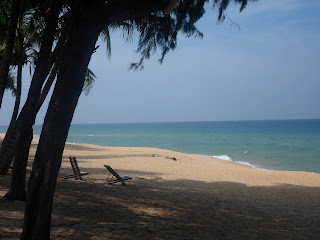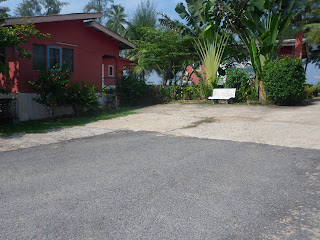
Rantau Abang, Terengganu
Tuesday, September 25, 2012
Leatherback Land

At 22km north of K.Dungun and 80km
south of K.Terengganu, is probably the most talked about tourist spot in
Terengganu. There was a time when a great number of giant leatherback
turtles came to Rantau Abang to lay their eggs between May and August.
(Peak egg laying months are June and July). The beach terrain here is
favourable as it has a steep and deep slope so that the turtle can
'land' straight up the beach. If the beach has a shallow and gradual
slope, the turtle would have to spend much of her energy wading through a
fair distance before finding a suitable nesting site closer to the
vegetation line. She must conserve as much energy as possible for what
she has to do later. The mother turtle comes up in the cover of night to
lay her eggs. Leatherback turtles can grow to a length of 2m and easily
weigh up to 500kg. Unlike other turtles species who have hard bony
shells, they have soft, leathery shells or carapace with 7 ridges
running longitudinally down. The design and shape of the carapace
reduces water friction and together with the long flippers helps the
turtle propel smoothly through water. This is a more suitable design,
for these long distance swimmers have to travel across great oceans
every 2 to 3 years to return to the same breeding ground. It is believed
that the long distance travel is related to seasonal drifts of the
jellyfish.
 |
Graceful reptiles in the water, on
land their weight and shape can be cumbersome. Each female nests between
5 to 9 times per season and each nest has between 50 to 140 eggs. The
male, on the other hand, never comes ashore. Once the mother turtle has
laid her eggs and covered them, she rests for a bit and then makes her
way back into the sea. Exhausted from the ordeal, she swims out into the
open sea to feed and replenishes her energy. This is the time when she
is most vulnerable to shark attacks. There have been reports of
leatherbacks with disfigured fins and wounds caused by sharks.
In the 1950's, there were around
11,000 nestings reported at Rantau Abang. By 1999, it had dropped to
fewer than 10 nestings. There are a number of factors attributed to the
sharp drop in numbers. In the early years when there were no rangers
monitoring the beach, local tourists were seen riding on the turtles,
pulling their flippers, shining flashlights into the poor, suffering
creature's eyes and all sorts of gross misconduct. Turtles are extremely
sensitive creatures and are not accustomed to such stress. On top of
the terrible treatment on land, high activity of trawlers scouring the
coastal waters and pollution lingering around the coastline were added
dangers. Leatherbacks and other turtles were often trapped in nets that
slowly drowned them, killing 100,000s every year worldwide. Adding to
the turtles' misfortunes, the turtle eggs were collected by locals to
sell in the markets. The locals claim that these eggs have aphrodisiac
and beautifying properties although there is no scientific proof for
these claims. It is reported that their nutritional value is even less
than that of a chicken egg. Turtle eggs are still sold at markets around
Terengganu and will continue to do so until authorities realise the
importance of protecting the species at every stage of its lifecycle and
development.
 |
If only there was more concerted effort to educate the people on the sensitivities of these turtles then perhaps that could in a small way help arrest the disappearing population.
 |
For more information on the
leatherbacks, there is a Turtle Information Centre managed by the
Department of Fisheries at Rantau Abang. The rangers have been
patrolling the beaches to ensure safety for the turtles when they come
onto shore to lay their eggs. They have also released 100,000s
leatherback hatchlings back into the sea through a series of successful
incubation and release programmes. The centre is open every day except
Friday and public holidays.
Rantau Abang has seen its heydays.
Today, many bypass this place, in search of other interests. The turtles
seldom land on the beaches due to the excessive harassment from local
visitors and fishermen. Most of all, these turtles are dying off and if
you get to see one, you may be the last few people to ever see them.
Soon there will be none left.
The town seems more like a ghost town.
To recommend a place to stay would be difficult for there is no telling
how long the motels will sustain themselves for lack of visitors.
However, the beaches are beautiful.. a dream really and extremely quiet.
Just as it was years ago...

Rantau Abang is one of only six places in the world visited by these turtles, from the months of May to September.
De'Teratai Beach Resort: Prestine Turtle Beach of Rantau Abang
This is not a star rated kind of hotel. Operated by a local Malay family, the rooms are quite basic. They are chalets with air-con and bathroom attached. There are a few of these resorts in the area but this resort is nearest to the beach.Note that this resort does not serve food. There is also no water kettle. The nearest town to get some decent food is Dungun.
Unique Quality: Near beach. Beach is clean and sea water is clear.
- Opinion of Price: about average
- Related to: Family Travel, Beaches
- Written June 8, 2008
- n/P: 0199496150 / 0179878454
Read more: http://www.virtualtourist.com/hotels/Asia/Malaysia/Negeri_Terengganu/Kampong_Rantau_Abang-1288753/Hotels_and_Accommodations-Kampong_Rantau_Abang-MISC-BR-1.html#ixzz27XfWYKf0
Subscribe to:
Posts (Atom)





























